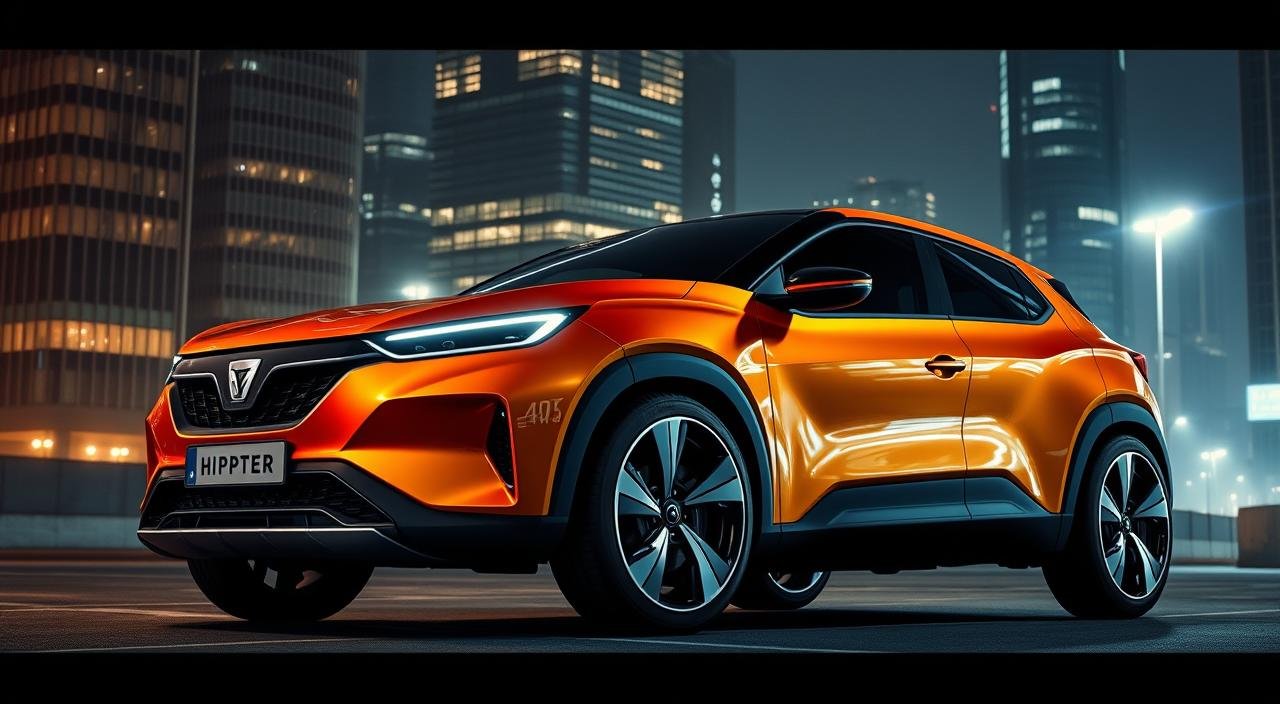
Oct
Electric cars under Rs 15 lakh make up only 2% of India’s EV market. But, this number is set to jump with new players aiming for more people to buy electric. The Dacia Hipster Concept is seen as a big change in the affordable electric car world.
MG Motor India is getting ready to launch its second electric car in India. They’ve shared a teaser video for a new EV coming to the UK in Q4 2022. This has people wondering about the car they’ll bring to India. The concept car is a crossover with a length of 4,300mm.
The EV has a bold orange paint job with black accents on the doors and roof. It also has 17-inch dual-tone wheels and sleek LED tail lamps. The Indian version will be inspired by this UK model but will also have local touches.
MG President Rajeev Chaba said the new EV will be for the mass market. It will cost between Rs 10-15 lakh ex-showroom. This makes it a rival to the Tata Nexon EV, which costs between Rs 14.29-16.90 lakh. The car is expected to launch in early 2023, with a focus on using local parts to keep prices low.
Key Takeaways
- Dacia Hipster Concept enters the affordable EV segment under Rs 15 lakh
- MG Motor India develops its second electric vehicle with mass market appeal
- The concept car measures 4,300mm featuring orange paint with black accents
- Pricing strategy positions it between Rs 10-15 lakh ex-showroom
- Heavy localization of parts ensures competitive pricing against Tata Nexon EV
- Launch scheduled for early 2023 targeting India’s growing EV market
Overview of the Dacia Hipster Concept
The car world is changing fast with Dacia’s new electric vehicle. This small city car is a big step towards affordable electric cars. It shows that you can have a modern car without spending a lot.

What is the Dacia Hipster Concept?
The Dacia Hipster Concept is a small electric car made for city life. It’s shorter than the MG ZS EV, making it easy to drive in tight spaces. Renault’s Dacia brand aims to make electric cars affordable for everyday use.
Key Design Features and Innovations
The design is unique, with a boxy shape that’s big inside but small outside. It has:
- Dual-tone colors for a cool look
- Modern LED lights everywhere
- A connected tail lamp that goes across the back
- A practical inside that’s easy to use
Target Audience and Market Positioning
Dacia made the Hipster Concept for city workers and families. It’s for those who want an electric car that’s affordable and practical. This way, Dacia can compete with more expensive EVs while keeping the car useful for daily drives in India.
Comparison with MG Comet
Dacia and MG are entering the compact electric vehicle market with different plans. They both want to attract buyers looking for affordable, practical cars for city driving. Their designs, prices, and tech features show how they see the Indian market.
Design Philosophy: Dacia vs. MG
MG goes for a crossover look with its 4,300mm length. It aims for easy city driving and a strong presence on the road. The brand features swanky dual-tone wheels, an orange color, and sleek LED tail lamps.
Dacia, on the other hand, keeps things simple. It focuses on what’s essential without losing functionality. This shows how each brand sees what customers want in today’s car market.
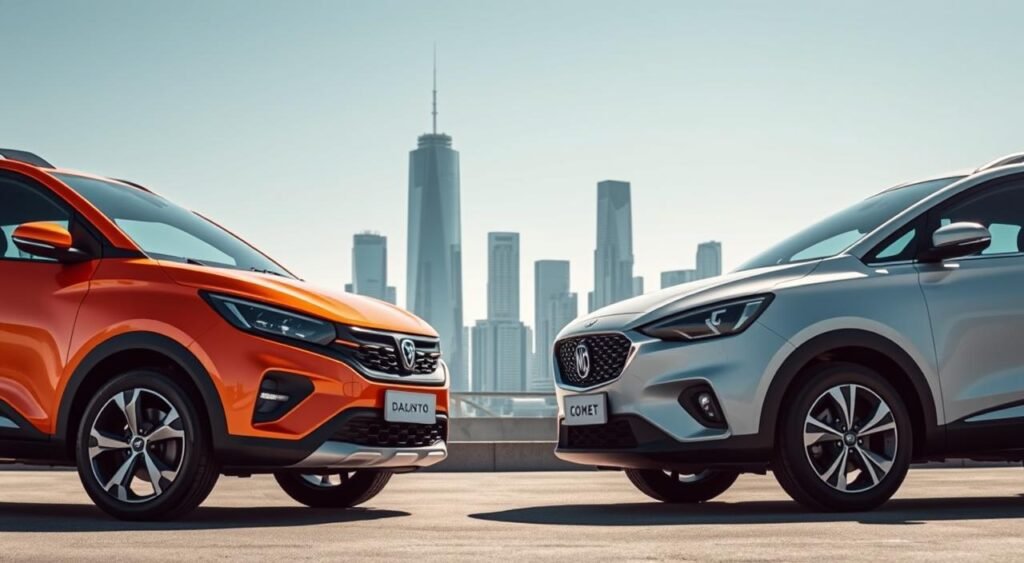
Pricing Strategies and Market Competition
MG is aiming for the Rs 10-15 lakh range, making its car more affordable than the ZS EV. Both brands are working hard to keep prices low by using local parts. The Tata Nexon EV is also in the mix, priced between Rs 14.29-16.90 lakh.
| Model | Price Range (Rs Lakh) | Market Position |
|---|---|---|
| MG Comet | 10-15 | Entry-level EV |
| Tata Nexon EV | 14.29-16.90 | Established compact |
| MG ZS EV | 21.99-25.88 | Premium compact |
Technological Advancements in Both Models
MG’s car has a setup that’s all about being efficient. It’s compared to the ZS EV’s 145PS motor and 44.5kWh battery, which goes 419km. Dacia focuses on tech that’s reliable and easy to maintain.
Both brands know Indian buyers want proven tech, not new, untested features. This guides their tech choices.
Performance and Specifications
The Dacia Hipster Concept is designed for city driving. It’s made for those who want an electric car but don’t want to spend a lot. This car is perfect for those looking to start with electric vehicles without breaking the bank.
Engine Options and Performance Metrics
The Hipster Concept has a powertrain made for city driving. It’s not as powerful as the MG ZS EV’s motor, but it’s more efficient. This choice helps keep costs low while providing enough power for daily drives.
It’s all about being efficient, not just fast. The electric motor gives quick acceleration and smooth driving. This makes it great for city driving.

Battery and Range Expectations
The battery is smaller than the MG ZS EV’s, but it’s enough for daily city driving. It’s lighter and cheaper, making the car more affordable. This is perfect for those who don’t need a lot of range.
Driving Experience: What to Expect
The car is short and easy to maneuver in tight spaces. It’s great for parking and navigating through crowded streets. The high seating position gives you a better view of the road. Plus, it’s quiet and smooth, perfect for city driving.
Potential Impact on the Indian Market
The Indian car market is changing fast, with more people wanting electric cars. The Dacia Hipster Concept could be a big change. It’s all about finding cars that are both affordable and good for city driving.
Growing Interest in Compact Cars
Indian cities are getting busier, making small cars more appealing. Electric cars are cheaper to run than petrol ones. They also fit with the government’s push for green transport.
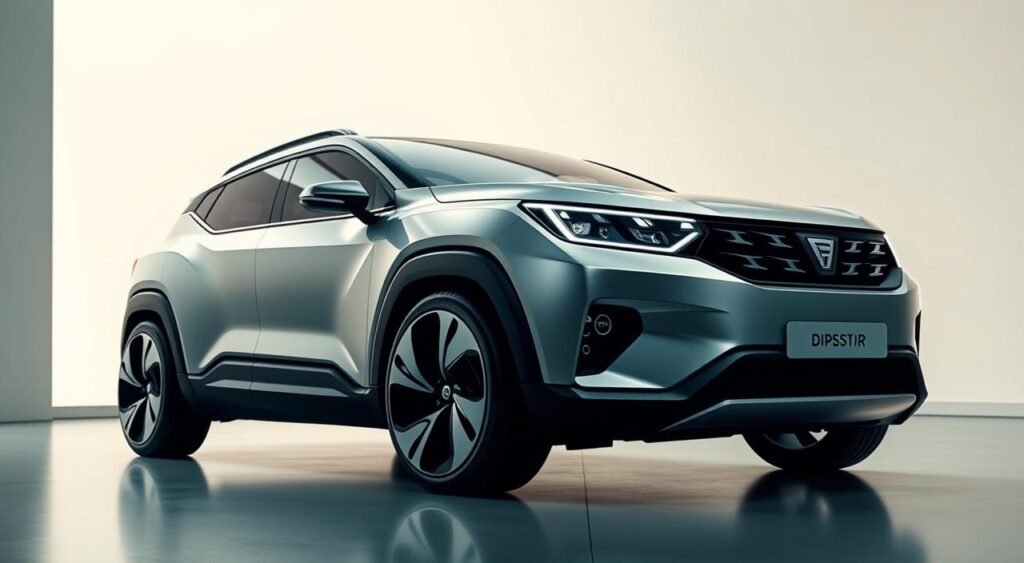
How the Hipster Concept Fits Indian Consumer Preferences
The MG Comet rival is made for those who want the latest tech without spending too much. People in India like connected technology, bright lights, and cool designs. Making cars here helps keep prices down while keeping quality high.
Competitive Landscape with Local Manufacturers
The electric car market is very competitive:
| Model | Price Range (Rs Lakh) | Segment Position |
|---|---|---|
| Tata Nexon EV | 14.29 – 16.90 | Electric Crossover |
| MG ZS EV | 22.98 – 26.00 | Premium Electric |
| Tata Tiago EV | 8.69 – 11.99 | Entry Electric |
Tata Motors leads in affordable electric cars with good prices and lots of service points. The Dacia Hipster Concept aims to fill a gap between the cheapest and most expensive cars, creating a new chance in the market.
Expert Opinions and Industry Responses
The Dacia Hipster concept car has caused a buzz in the car world. Market experts and car makers are keeping a close eye. They’re interested in how it might change the affordable electric car market in India.
Reactions from Automotive Experts and Critics
Car industry pros see the Hipster as a big deal for those on a budget. It’s a move towards practical city driving. They like how it focuses on what’s needed, not just fancy stuff.
This idea is similar to the Tata Nexon EV’s success. It shows there’s a market for cars priced between Rs 14-17 lakh.

Anticipated Consumer Reception
MG Motor India’s Rajeev Chaba says they’re aiming for affordable electric cars. This move reflects growing eco-awareness in India. The car world thinks there will be a lot of interest in electric cars under Rs 15 lakh.
People want modern features but at prices they can afford. This makes small electric cars more appealing.
Predictions for Sales Success
Experts are hopeful about the sales of affordable electric cars. Making cars in India will help keep prices down. This is key for selling a lot of cars.
Many car makers are exploring the concept car market. Data shows people want electric cars that:
- Can go over 200 kilometers a day
- Charge quickly
- Have smart car tech
- Are easy to maintain
These features make the Hipster a strong contender in India’s growing electric car market.
Future Developments and Launch Timeline
The Dacia Hipster Concept marks a big change in car trends for India. MG has said its second electric car will hit the market in early 2023. It will first be seen in the UK in the fourth quarter of 2022.
The company will start selling in big cities like Mumbai, Delhi, and Bangalore. These cities have seen a lot of growth in EV charging. This plan shows MG’s focus on making cars that fit urban needs.
Expected Launch Dates and Locations
MG will start by selling in big cities. By mid-2023, they plan to reach tier-two cities. Dealerships in Chennai, Pune, and Hyderabad will get cars within six months.
This slow start lets MG see how people react. It also helps them build a strong service network in key areas.
Possible Variants and Editions
Dacia will offer different battery sizes to fit various budgets. The cheapest model will cost under Rs 10 lakh. The pricier versions with bigger batteries could go up to Rs 15 lakh.
These cars will have different features like better sound systems and safer materials. This way, Dacia can appeal to more people.
Long-Term Vision for Dacia in India
Dacia wants to make cars more affordable by using local parts. They aim to make electric cars available to more people. This includes making cars that are practical for city driving and priced right.
They’re talking to local suppliers to use 70% local parts in three years. This shows Dacia’s big plans for the Indian EV market.
FAQ
What is the expected price range for the Dacia Hipster Concept in India?
Dacia hasn’t shared the price yet. But, it’s expected to be affordable. It might cost less than MG’s EV, which is priced between Rs 10-15 lakh.
How does the Dacia Hipster Concept compare to the MG Comet in terms of size?
Both are under 4,300mm long. They’re perfect for city driving. The Dacia Hipster has a boxy design, while the MG ZS EV is a bit bigger.
What are the key design features of these new compact EVs?
The Dacia Hipster has modern LED lights and a cool color scheme. MG’s EV has a sleek look with orange paint and black accents. It also has futuristic wheels and LED tail lamps.
When will MG’s new compact EV launch in India?
MG plans to launch it in early 2023. It will first be available in big cities with good EV charging.
What battery and range specifications can we expect from these compact EVs?
They’ll have smaller batteries than the MG ZS EV. Their range will be less, making them great for city driving.
How will these vehicles compete with the Tata Nexon EV?
MG’s EV will compete with the Tata Nexon EV. MG aims to be cheaper, with prices between Rs 10-15 lakh. It will have cool features like LED lights and dual-tone styling.
What is the localization strategy for achieving competitive pricing?
MG and Dacia will use local parts to keep prices low. MG plans to make more parts locally to cut costs even more.
Who is the target audience for these compact urban EVs?
They’re for people who want an affordable electric car. These cars are perfect for city driving and are easy on the wallet.
What performance metrics can drivers expect from these compact EVs?
They focus on being efficient, not just fast. They’re great for city driving, with a small turning radius and a high seat position.
What are the future car models and automobile trends indicated by these launches?
These launches show a move towards affordable, practical EVs. The goal is to make electric cars more accessible. We might see different versions based on battery size and features.
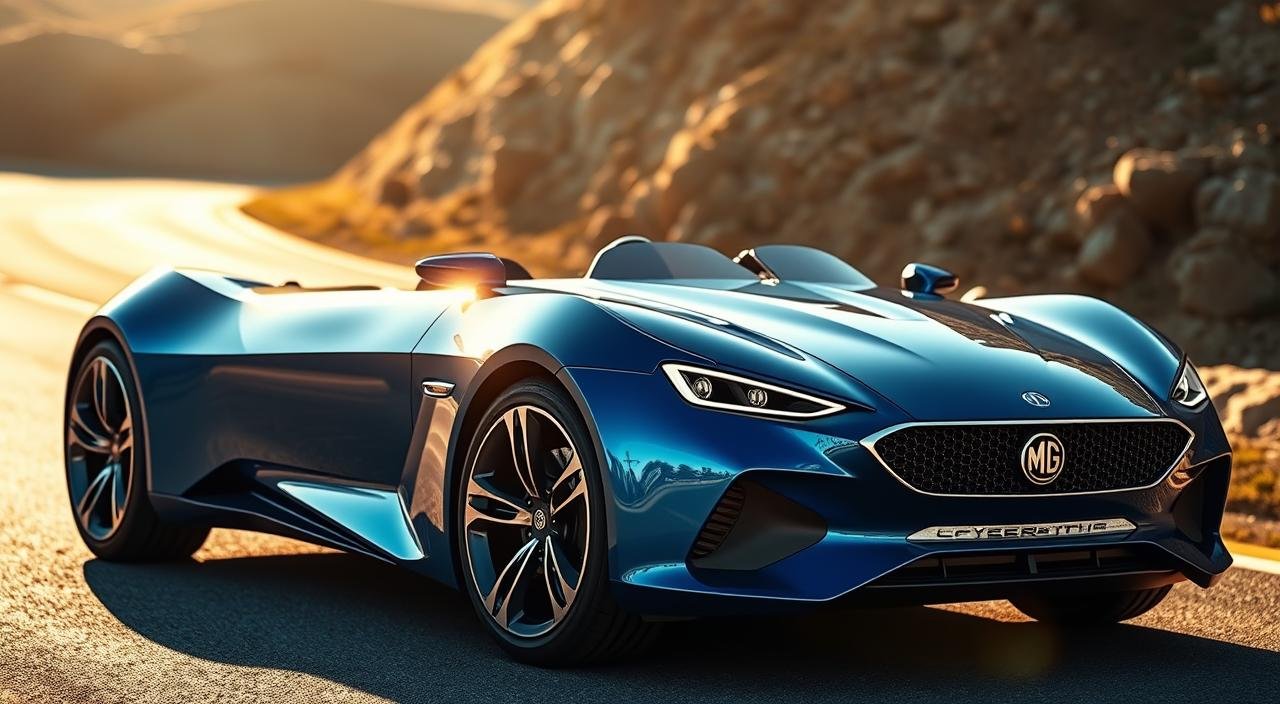
Aug
Can an electric vehicle roadster from MG challenge the design supremacy of traditional sports cars on Indian roads? The MG Cyberster Design is a big change for MG, known mainly for SUVs like the Hector. This electric roadster breaks new ground with its bold styling and futuristic look.
The Cyberster has scissor doors that open with just a button. Its low, wide stance makes it stand out and grab attention. Its roadster design is different from the usual designs in India’s electric car market.
This bold electric roadster shows what happens when car makers take risks with design. The MG Cyberster Design mixes eye-catching looks with smart engineering. It’s a car that looks as advanced as it is electric.
Key Takeaways
- MG Cyberster represents a dramatic departure from the brand’s traditional SUV focus
- Functional scissor doors open with a simple button push for theatrical entry
- Low, wide stance creates commanding road presence on Indian streets
- Sweeping roadster profile challenges conservative EV aesthetics in the market
- Design combines striking visual elements with practical engineering solutions
- Every curve serves both aesthetic appeal and functional purpose
Introduction to MG Cyberster Design
The MG Cyberster is a big step for MG in the electric car world. It’s a roadster that looks amazing and works well. Its design shows MG’s goal to change what electric sports cars can be today.
Overview of the MG Cyberster
The Cyberster has scissor doors that open up, not out. These doors have sensors to avoid hitting things. It’s a two-seater with a low profile and wide stance, just like a classic roadster.
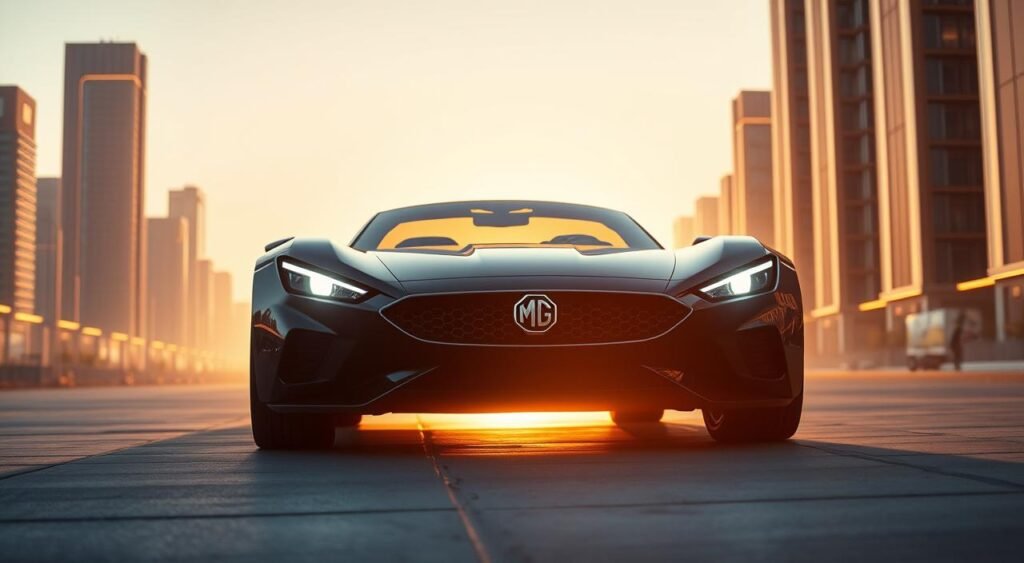
| Dimension | Measurement | Design Impact |
|---|---|---|
| Length | 4,535 mm | Compact for agility |
| Width | 1,913 mm | Wide track for stability |
| Height | 1,329 mm | Low center of gravity |
| Wheelbase | 2,690 mm | Extended for smooth ride |
Significance of Design in Electric Vehicles
Electric cars need new designs because they don’t have engines. The Cyberster’s design cuts through air and looks cool. It shows how EVs can be both beautiful and efficient.
Bold Front-End Aesthetics
The MG Cyberster stands out as a trendsetter in the automotive world. Its striking front-end design grabs attention. It perfectly blends elegance with performance, setting new standards for EV looks.
Signature Headlights and Grille Design
The Cyberster’s LED headlamps make a bold statement. They are nestled in unique petal-shaped daytime running lights. The wide grille and sharp bonnet lines add to the car’s bold look.
This design keeps things simple yet stylish. It shows off the sleek look that modern electric cars are known for.

Aerodynamic Lines and Sculpted Bodywork
Every part of the Cyberster is designed with purpose. The long bonnet meets a short rear deck, giving it classic roadster looks. This car is a trendsetter because of its:
- Clean sculpting that maintains balanced proportions
- Smooth transitions between body panels
- Wind-optimized surfaces for improved efficiency
- A low-slung profile that enhances the sporty character
The bodywork is a blend of beauty and function. It guides air smoothly and keeps the Cyberster looking sleek. This design makes the MG Cyberster a leader in electric roadster styling.
Modern Interior Features
The MG Cyberster’s interior is a mix of the latest tech and top-notch craftsmanship. Every part shows a focus on quality, from solid doors to perfectly aligned panels. The interior design is as stunning as the outside, making every drive special.
Dashboard Design and Technology Integration
The dashboard is designed for the driver, with clear digital displays. A curved cluster shows important info, and the central screen handles entertainment and settings. It also has voice controls and connects to smartphones, making it easy to use.

- Triple-screen setup with customizable displays
- Wireless Apple CarPlay and Android Auto
- Ambient lighting with multiple color options
- Digital climate control system
Material Choices for a Premium Feel
MG picked materials that are both luxurious and strong. The dashboard and doors have soft-touch surfaces, while metal adds a nice look. The seats are covered in quality leather with contrasting stitching that matches the car’s color.
| Interior Component | Material Used | Premium Feature |
|---|---|---|
| Dashboard | Soft-touch polymer | Anti-glare coating |
| Seats | Nappa leather | Heated and ventilated |
| Steering wheel | Perforated leather | Paddle shifters |
| Door panels | Alcantara inserts | Illuminated trim |
The cabin’s quality is top-notch, with precise panel gaps and smooth components. This tech integration makes the interior feel both modern and welcoming for daily use.
Color Palette and Customization Options
The MG Cyberster Design offers bold color choices. These options make the roadster stand out. Each color is picked to match the car’s sleek lines and modern look.
Available Colors and Their Impact
The MG Cyberster has two standout colors:
- Flare Red – A bright, eye-catching shade that highlights the car’s sporty vibe
- Nuclear Yellow – A bold color that matches the EV style of this modern sports car
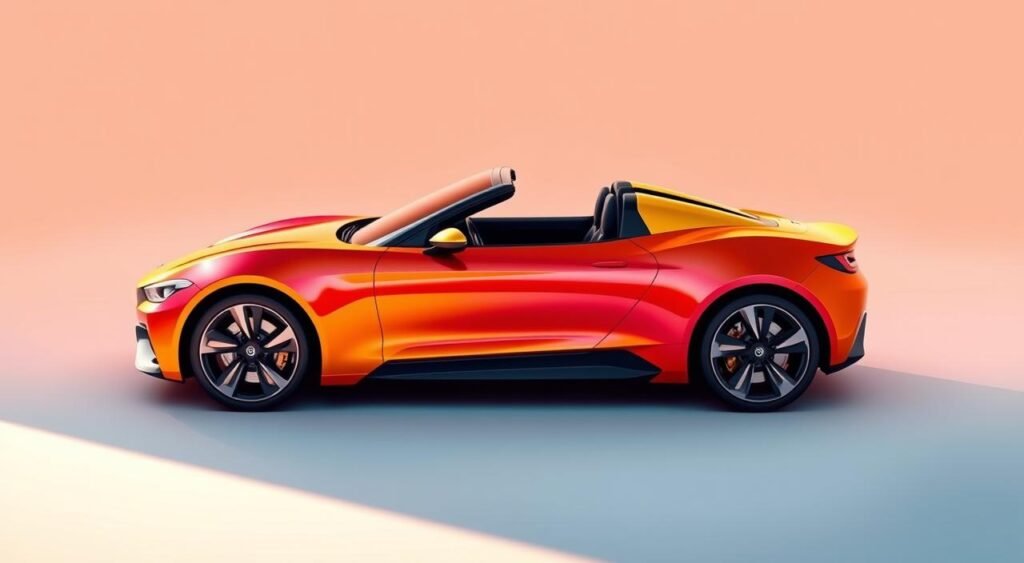
There are also more subtle colors. These might appeal to those who prefer a quieter look. But, they might not show off the MG Cyberster’s design as much.
Personalization Features for Owners
Customization goes beyond just colors. Owners can choose from different trim packages and accents. This lets them make a car that shows off their style while keeping the Cyberster’s EV look.
The mix of bold colors and subtle accents lets each owner make their unique roadster.
Innovative Lighting Technology
The MG Cyberster changes nighttime driving with its advanced lighting system. It shows how lights can look good and work well, setting new standards for EVs.
LED Lighting and Its Benefits
The Cyberster’s LED light bar makes a bold statement at the back. It makes the car look wider and lights it up better. The arrow-shaped tail lamps add a unique touch, like concept cars.
- They use less energy, saving on range.
- They last longer than old bulbs.
- They light up fast, without waiting.
- They shine light exactly where it’s needed, for safety.
Daytime Running Lights and Signature Design
The Cyberster’s petal-shaped DRLs are a design leap. They make the car’s front look unique and bright. This shape is clear in the day and makes the car stand out.
MG shows it can make EVs that are both safe and stylish. The lights fit perfectly with the car’s design, showing safety doesn’t have to mean sacrificing looks.
Performance-Driven Design Elements
The MG Cyberster is a true trendsetter in the automotive world. It perfectly combines style with performance. The soft-top fabric roof is a great example of this, opening in just 10 seconds. It keeps the car’s look sleek when closed.
Drivers can open the roof at speeds up to 50 kmph. This makes it easy to change the weather without stopping.
Weight Distribution and Handling
The Cyberster’s design focuses on balance. The battery pack is placed low in the car. This makes the car’s center of gravity as good as traditional sports cars.
The 20-inch alloy wheels are a big part of the car’s look. They also help the car grip the road well. This makes the Cyberster handle like a dream.
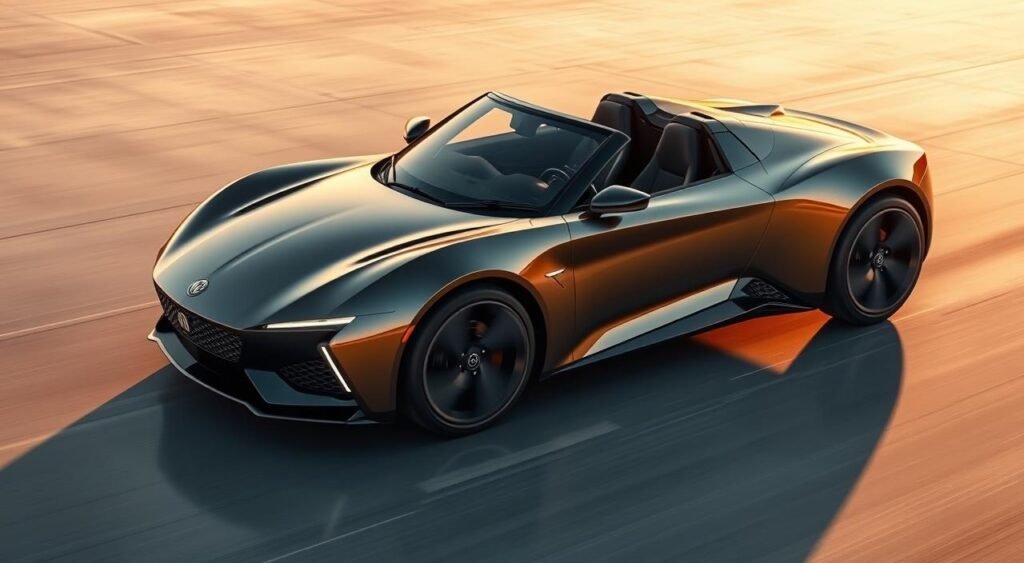
Impact of Design on Efficiency
The Cyberster’s design is key to its long range. Its body is shaped to cut through the air with ease. Every curve and crease has an aerodynamic purpose.
The front splitter and rear diffuser help a lot. The car’s doors and mirrors are designed to reduce wind resistance. The active grille shutters also help by adjusting airflow. These features help the Cyberster go further without losing its cool looks.
Conclusion: The Allure of the MG Cyberster
The MG Cyberster is a big leap in electric roadster design. It mixes classic sports car looks with the latest in electric tech. Its sleek design grabs attention from all sides, thanks to modern tech that boosts both performance and ease of use.
This car stands out in a world filled with sedans and SUVs. It brings a fresh, exciting vibe to the road.
Recap of Key Design Elements
The Cyberster shows MG’s big plans for electric cars. Its scissor doors add a cool touch, making getting in and out a show. The soft-top roof lets you drive with the wind in your hair, keeping the car’s sleek look.
Its lines and shapes flow smoothly, making it a feast for the eyes. The LED lights add to its look, shining bright at night in cities like Mumbai or Delhi.
The Future of Roadster Design in EVs
The Cyberster hints at a bright future for electric roadsters in India. It shows EVs can be thrilling and emotional, not just about saving fuel. As batteries get better and charging spots grow, more cars like this will hit the roads.
The Cyberster’s mix of new tech and stunning design sets a new standard. It proves electric cars can be just as fun to drive as their gas-guzzling cousins.
FAQ
What are the most distinctive design features of the MG Cyberster?
The MG Cyberster has scissor doors that open with a button press. It also has narrow LED headlamps and a full-width LED light bar at the back. The car has a classic roadster look with a low stance and wide wheels.
How does the MG Cyberster’s exterior design compare to traditional EV aesthetics?
Unlike many EVs, the Cyberster has bold styling. It has dramatic scissor doors and a sweeping profile. Its long bonnet, short rear deck, and 20-inch alloys give it a bold stance.
What color options are available for the MG Cyberster?
The Cyberster comes in Flare Red and Nuclear Yellow for a bold look. But, it also has more subtle colors for those who prefer less flash.
How practical are the scissor doors for everyday use?
The Cyberster’s scissor doors are practical for daily driving. They have sensors to avoid hitting objects and close with a solid sound. This shows the car’s premium quality.
What cutting-edge technology is integrated into the Cyberster’s lighting system?
The Cyberster has LED headlamps with unique DRLs. Its rear light bar and arrow-shaped tail lamps give it a futuristic look.
How does the retractable soft-top affect the vehicle’s design and functionality?
The soft-top operates quietly and can be changed at speeds up to 50 kmph. It retracts neatly, keeping the car’s lines clean.
Is the MG Cyberster positioned as an automotive trendsetter in India’s EV market?
Yes, the Cyberster is MG’s bold move into the EV market. It combines futuristic design with innovation, making it a leader in India’s EV scene.
How does the interior design complement the bold exterior aesthetics?
The interior focuses on tech and premium materials. It has well-designed panels and solid doors. This creates a space that matches the car’s striking look.

Aug
Imagine if the Renault Triber facelift had all the features customers wanted. The Indian MPV market is tough, balancing cost with quality. The Renault Triber is a budget-friendly 7-seater for families, but it misses some key updates.
The Renault Triber has a design that fits families on a budget. It’s a smart choice for those who need a car that’s easy to use. Even with a facelift, it misses five big chances to stand out more in the market.
Indian buyers look for more than just basic features. The Renault Triber Facelift is up against rivals in a crowded field. Knowing what it misses helps buyers decide if it’s worth waiting for the next update.
Key Takeaways
- The Renault Triber facelift maintains its position as an affordable 7-seater MPV in India
- Five critical areas could have strengthened the vehicle’s competitive advantage
- Market competitors face extended waiting periods, giving Triber an availability advantage
- Customer expectations include advanced features typically found in higher segments
- Future updates might address current shortcomings based on market feedback
- Price positioning remains competitive despite missing enhancement opportunities
Overview of the Renault Triber Facelift
The Renault Triber facelift is a top pick for affordable 7-seater MPVs in India. It keeps its price and useful features. But, some updates could have made it even better.
The new model keeps what made the original great. Yet, it misses chances to meet today’s consumer needs.
Introduction to the facelifted model
The updated Triber has new looks and small changes inside. It’s short at 3,990mm, perfect for tight city spots. It has a new front grille, updated bumpers, and fresh colors.

Key features retaining popularity
The Triber’s modular seats are a big hit. The EasyFix seats can be set up in different ways:
- 7-seater family mode
- 5-seater with more room for luggage
- 4-seater for the most space for bags
- Flat-folding for big items
It comes with dual airbags, ABS, rear sensors, and a speed alert. The 8-inch screen supports Android Auto and Apple CarPlay.
Target audience and market position
The Triber is for first-time buyers and families looking for a good deal. It’s priced lower than the Maruti Invicto, making it a smart choice for those who want space and flexibility without spending too much.
Missed Opportunity: Advanced Infotainment System
The updated Renault Triber misses the mark on tech features that today’s drivers want. It keeps its practicality but its infotainment system is a major letdown. This could hurt its standing in the affordable MPV market.
Lack of updated software
The Triber’s infotainment system looks old compared to others. Cars like Maruti have systems that are easy to use and quick. The Triber’s software is slow and lacks the modern feel that city drivers expect.
Switching between music and maps is slow. The graphics and menus are also outdated. Making these changes would have been easy during the update. A new interface could make driving much better.
Absence of wireless connectivity options
One big thing missing from the Triber is wireless phone connection. While other budget cars offer this, the Triber requires a USB cable. This makes the car look cluttered and less convenient.
Today, wireless connection is seen as a must-have, not a luxury. Without it, the Triber falls behind other cars in its price range. This might make people choose other cars that are more connected.
Missed Opportunity: Enhanced Safety Features
Safety is a big worry for people looking at Renault Triber customer reviews. The updated model didn’t add new safety features. This makes it less safe compared to other cars on the market. Families want cars that are safe and meet today’s standards.
Comparison with competitors
The Triber doesn’t match up when it comes to safety features. The Maruti Baleno now has 6 airbags in its top versions. This shows how safety has become more important in budget-friendly cars.
Other cars like the Honda Amaze and Hyundai Grand i10 Nios also have better safety features. They offer electronic stability control and hill hold assist in their best versions.
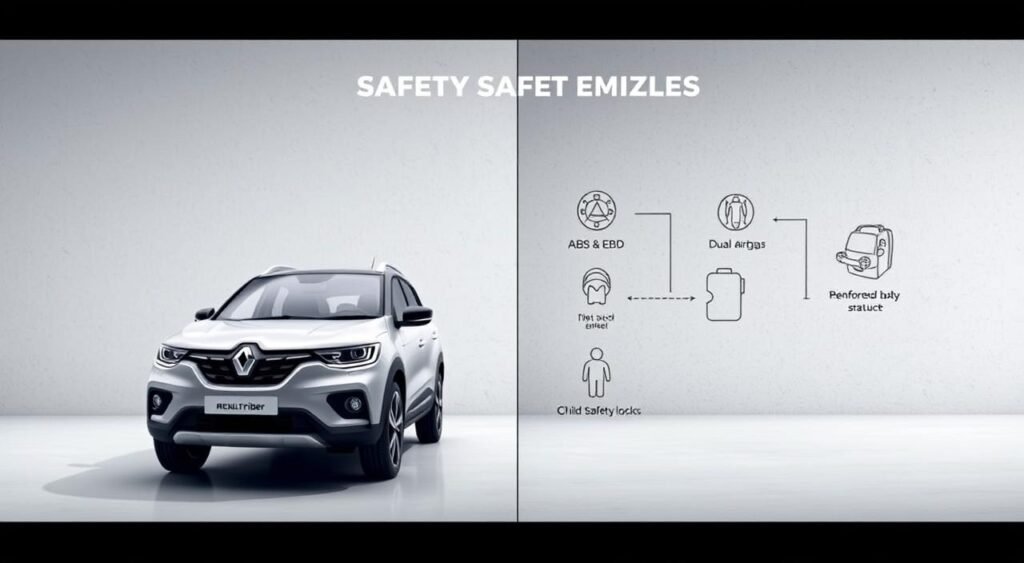
Renault Triber feedback often talks about the lack of safety features. The current model has only dual front airbags, ABS with EBD, and rear parking sensors. This seems old-fashioned compared to what others offer.
- Side and curtain airbags across variants
- Electronic stability programs
- Traction control systems
- ISOFIX child seat anchors as standard
Importance of modern safety standards
India is focusing more on road safety. The Uttar Pradesh government has started a Rs 10 crore AI-based accident prevention program. This shows how serious safety is becoming.
Modern families looking at Renault Triber customer reviews want cars that keep everyone safe. Cars that were once only in luxury models are now in more affordable ones from other brands.
Missed Opportunity: Stylish Exterior Design Touchups
The Renault Triber Facelift has made some small changes but misses the mark. Other cars are getting big updates in looks. The Triber’s design is too safe, missing out on modern styles that buyers want.
Review of the existing design
The Renault Triber updates keep the car’s useful design. The front gets small changes to the grille and bumper. But, it sticks with old halogen headlights, unlike the newer LED lights in other cars.
The sides look the same as before, with the same wheels. Even the top models don’t get fancy alloy wheels.
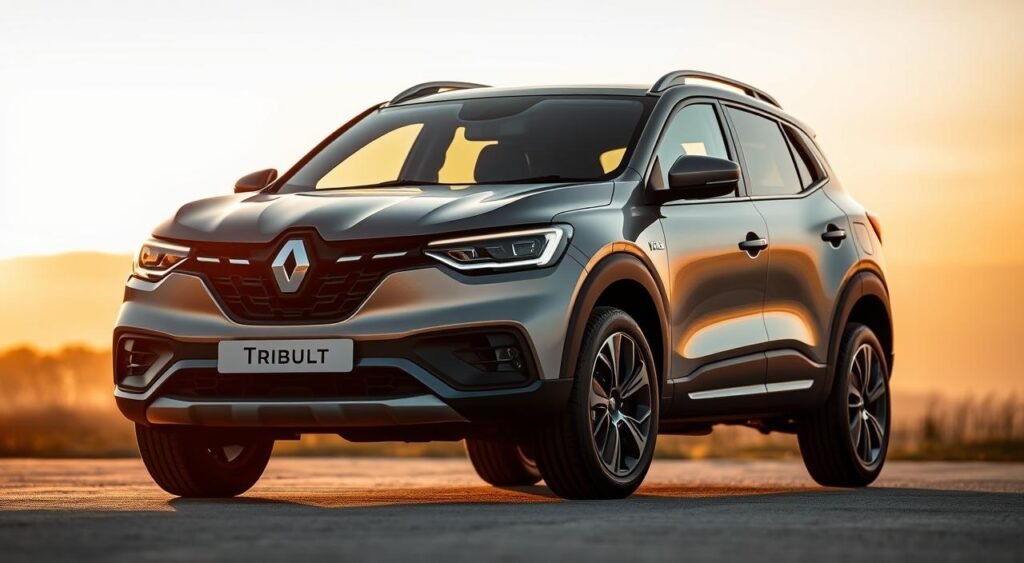
The back of the car also doesn’t change much. It keeps the old tail lamps and bumper. There are only a few chrome bits, which isn’t enough to make it look premium.
Consumers’ expectations for updates
People want cars that stand out more. Other brands offer special kits that change a car’s look. For example, Maruti has kits for the Fronx and Grand Vitara.
- Body cladding and skid plates
- Sporty alloy wheel designs
- Dual-tone paint schemes
- LED lighting signatures
- Bold grille patterns
The Renault Triber Facelift could have added these cool features without breaking the bank. Contemporary design elements are key for attracting young buyers who value looks as much as function.
Missed Opportunity: More Efficient Powertrain Options
The updated Triber keeps its single engine, missing a chance to offer more powertrain choices. Today’s market values alternative fuels, which could draw in cost-conscious buyers. They’re looking for better fuel economy.
Overview of current engine performance
The Triber uses a 1.0-liter naturally aspirated petrol engine. It makes 72 PS and 96 Nm of torque. This engine is okay for city driving but weak when carrying seven passengers.
The fuel efficiency is about 20 kmpl. While it’s good, it’s not the best compared to newer options.
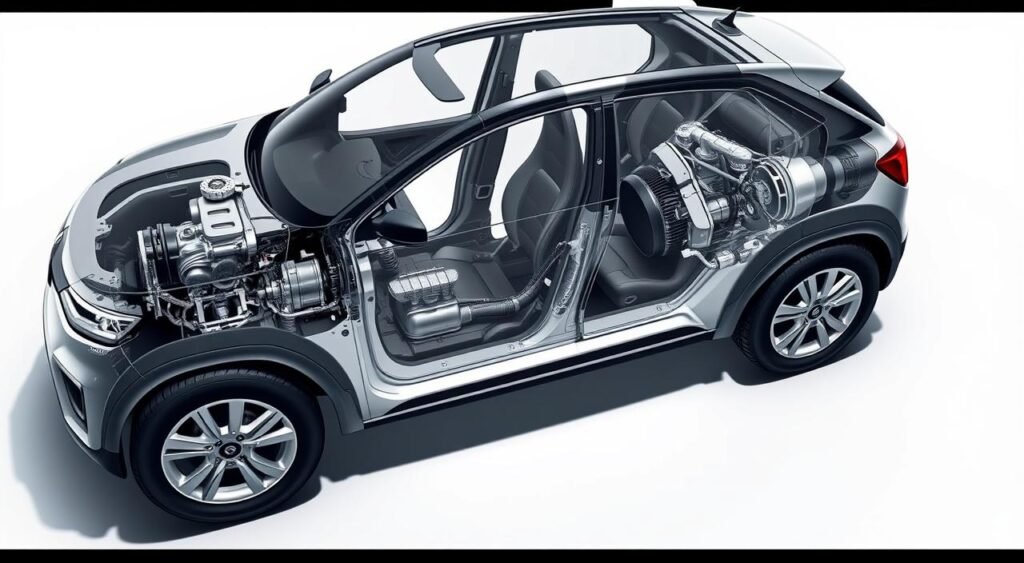
The current Renault Triber features include manual and AMT transmissions. The AMT makes city driving easier but doesn’t boost fuel efficiency or performance much.
Potential for hybrid or electric variants
Competitors like Maruti Suzuki have introduced strong hybrid systems and CNG variants. These options offer substantial fuel savings and lower emissions. The lack of these options limits the Triber’s appeal in an eco-conscious market.
A mild hybrid system could boost fuel efficiency by 15-20%. A CNG option could cut running costs by up to 40%. With fuel prices rising and more people caring about the environment, these options are missed chances. They could expand the Triber’s customer base and strengthen its spot in the affordable seven-seater market.
Missed Opportunity: Interior Comfort and Space Enhancements
The Renault Triber facelift has a functional interior but misses the mark. It keeps its seven-seat layout but lacks the premium feel buyers want. This is a big missed chance to make the Triber more appealing.
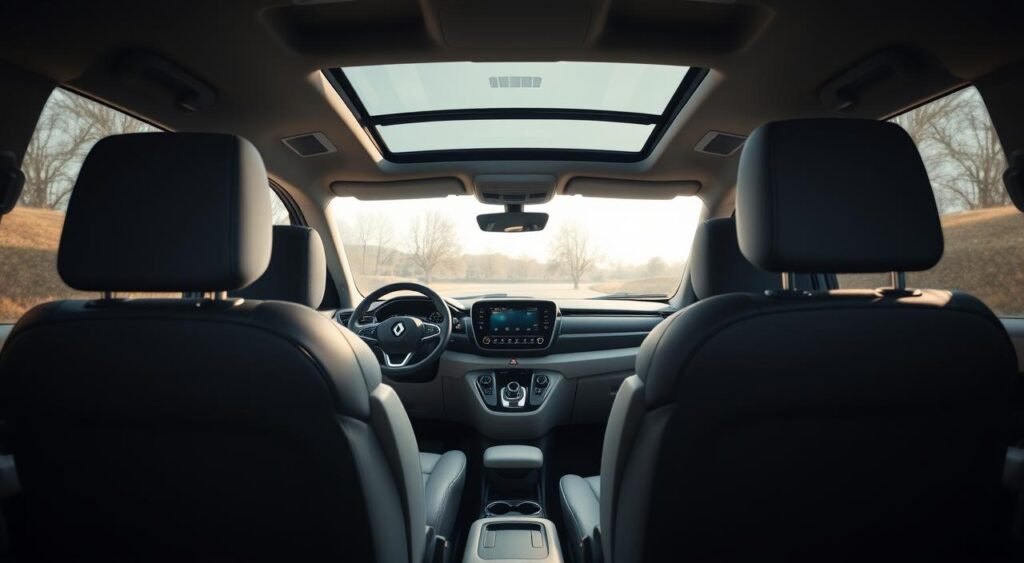
Cabin quality and finishes
The Triber’s interior is mostly hard plastic, making it feel more like a work vehicle than a family car. The Maruti XL6, priced between Rs 11.84 lakh and Rs 14.99 lakh, has soft-touch materials on the dashboard and doors. The Triber’s seats are basic, not durable or comfortable enough for daily use.
Sound insulation is another area where the Triber could improve. At highway speeds, road and engine noise make it hard to talk between the third-row passengers and the driver.
Upgrade options that could attract buyers
There are several affordable ways to make the Triber’s interior more appealing:
- Rear AC vents for better passenger comfort
- Premium fabric or leatherette seat options
- Ambient lighting for a modern look
- Better door pad cushioning
- Improved floor mats and cargo organizers
These upgrades would meet real customer needs without raising the price too much.
Missed Opportunity: Pricing Strategy Adjustments
The Renault Triber faces tough competition in India, where price matters a lot. It has cool features like being able to seat 7 people in a small space. But, its price might need to change to compete with others who offer big discounts.
Current pricing in relation to rivals
The Triber is priced like many other cars, giving buyers lots of choices. Maruti Suzuki is leading with huge discounts. The Grand Vitara gets up to Rs 1.54 lakh off, and the Baleno and Fronx have discounts too.
These deals make other cars seem more affordable to Indian buyers who watch their budget closely.
Suggestions for competitive pricing
Customers have given Renault Triber feedback on how to make the price better. Here are some ideas:
| Strategy Type | Proposed Benefit | Target Customer |
|---|---|---|
| Exchange Bonus | Rs 25,000-40,000 | Upgrade buyers |
| Corporate Discount | Rs 15,000-20,000 | Salaried professionals |
| Rural Market Incentive | Rs 10,000-15,000 | Tier 2-3 city buyers |
| Festival Offers | Rs 30,000-50,000 | Seasonal buyers |
Changing the price could attract more customers. Exchange bonuses could draw in those upgrading from old cars. Corporate discounts might appeal to professionals who need a family car.
Customer Feedback on Misses
Real-world experiences from owners show the Renault Triber Facelift’s shortcomings. They share specific concerns that future buyers should think about before buying.
Insights from existing owners
Renault Triber customer reviews highlight common issues. Build quality is a big worry, with rattling sounds from dashboard panels after 10,000 kilometers. Service access is hard in smaller cities, where Renault dealerships are few.
Families who picked the Triber for its 7-seat layout are disappointed. They like the practicality but feel it lacks features that rivals offer at the same price.
Potential areas for improvement based on reviews
Reviews point out key areas for improvement:
| Improvement Area | Owner Complaints | Competitor Advantage |
|---|---|---|
| Premium Features | No sunroof or LED headlights in top variant | Maruti Ertiga offers both at similar pricing |
| Engine Refinement | Noisy at highway speeds | Honda BR-V provides quieter cabin experience |
| Interior Quality | Hard plastics throughout | Kia Carens uses soft-touch materials |
| Dealer Network | Limited service centers | Maruti has 3x more touchpoints nationally |
The Renault Triber Facelift’s good price doesn’t make up for daily issues. Budget-conscious families often choose well-known rivals, showing value goes beyond the initial cost.
Conclusion: The Future of Renault Triber
The Renault Triber facelift has promise but needs more work. It’s a good choice for Indian families looking for a budget-friendly seven-seater. But Renault missed the chance to make it stand out more.
Summary of missed opportunities
There are five key areas where Renault could have done better. The infotainment system doesn’t have wireless connectivity, which is now expected. Safety features are also lacking, with rivals having six airbags as standard.
The exterior design could be bolder to grab more attention. The engine options are limited to petrol, with no CNG or mild-hybrid choices. The interior could use more premium materials to match the price with competitors like Maruti Suzuki and Hyundai.
Recommendations for future models and updates
Future updates should focus on what customers want most. Adding wireless Android Auto and Apple CarPlay would improve the cabin. Matching safety standards with six airbags and electronic stability control is key.
Bolder grilles and LED lights could make the exterior more appealing. CNG variants would help with fuel costs in India. Premium seats and soft-touch dashboards would enhance quality. Smart pricing with exchange bonuses could make the Triber more competitive.
FAQ
What are the main areas where the Renault Triber facelift falls short compared to competitors?
The Renault Triber facelift misses in five key areas. It lacks wireless Android Auto and Apple CarPlay in its infotainment system. It also has fewer safety features than rivals, with only 6 airbags in some models.
Its exterior design updates are conservative. It doesn’t offer alternative fuel options like CNG or hybrid variants. The interior materials and comfort features are also basic.
How does the Renault Triber’s safety package compare to other MPVs in its segment?
The Renault Triber’s safety features are basic. Competitors like the Maruti Baleno offer 6 airbags as standard in higher trims. It lacks modern safety technologies like electronic stability control and hill hold assist.
These are important for safety-conscious families in India. The Triber also doesn’t have advanced driver assistance systems (ADAS).
What infotainment updates should the Renault Triber have included?
The Renault Triber should have wireless Android Auto and Apple CarPlay connectivity. These are now standard in competing models. The software interface needs to be improved to match rivals.
This is important for tech-savvy urban buyers who value seamless smartphone integration.
Are there any powertrain alternatives missing in the Renault Triber facelift?
Yes, the Renault Triber lacks alternative fuel options. Competitors offer hybrid and CNG variants. The Triber doesn’t have these options, which limits its appeal to buyers looking for better fuel efficiency.
What exterior design changes could have improved the Renault Triber’s appeal?
The Renault Triber could have had modern design elements. This includes LED lighting signatures, bold grille designs, and distinctive alloy wheel patterns. Competitors show how visual differentiation can make a car look more premium.
How does the Renault Triber’s pricing strategy need adjustment?
The Renault Triber needs more aggressive promotional strategies. Maruti offers big discounts on the Grand Vitara and Baleno. The Triber could benefit from similar incentives to attract more customers.
What interior improvements are customers expecting in the Renault Triber?
Customers want premium touches like those in the Maruti XL6. This includes better plastics, upgraded seat materials, and rear AC vents. They also want ambient lighting and improved sound insulation.
These upgrades would make long trips more comfortable without increasing costs too much.
What do Renault Triber customer reviews highlight as main concerns?
Customer feedback mentions build quality concerns and limited dealer network. The lack of premium features in higher variants is also a concern. These issues stop the Triber from meeting demand for well-equipped family vehicles.
